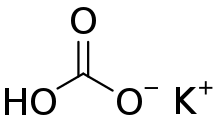Potassium bicarbonate
 | |
| Names | |
|---|---|
| IUPAC name
potassium hydrogen carbonate | |
| Other names
potassium acid carbonate | |
| Identifiers | |
3D model (JSmol) |
|
| ChEBI | |
| ChemSpider | |
| ECHA InfoCard | 100.005.509 |
| EC Number | 206-059-0 |
PubChem CID |
|
| |
| |
| Properties | |
| KHCO3 | |
| Molar mass | 100.115 g/mol |
| Appearance | white crystals |
| Odor | odorless |
| Density | 2.17 g/cm3 |
| Melting point | 292 °C (558 °F; 565 K) (decomposes) |
| 33.7 g/100 mL (20 °C) 60 g/100 mL (60 °C) | |
| Solubility | practically insoluble in alcohol |
| Acidity (pKa) | 10.329[1]
6.351 (carbonic acid)[1] |
| Thermochemistry | |
Std enthalpy of formation (ΔfH |
-963.2 kJ/mol |
| Pharmacology | |
| A12BA04 (WHO) | |
| Hazards | |
| Safety data sheet | MSDS |
| R-phrases (outdated) | R36 R37 R38 |
| NFPA 704 | |
| Flash point | Non-Flammable |
| Lethal dose or concentration (LD, LC): | |
LD50 (median dose) |
> 2000 mg/kg (rat, oral) |
| Related compounds | |
Other anions |
Potassium carbonate |
Other cations |
Sodium bicarbonate Ammonium bicarbonate |
Related compounds |
Potassium bisulfate Potassium hydrogen phosphate |
Except where otherwise noted, data are given for materials in their standard state (at 25 °C [77 °F], 100 kPa). | |
| Infobox references | |
Potassium bicarbonate (also known as potassium hydrogen carbonate or potassium acid carbonate) is a colorless, odorless, slightly basic, salty substance. According to the U.S. Food and Drug Administration (FDA), potassium bicarbonate is "generally recognized as safe".[2] There is no evidence of human carcinogenicity, no adverse effects of overexposure, and an undetermined LD50. It is among the food additives encoded by European Union, identified by the E number E501. Physically, potassium bicarbonate occurs as a crystal or a soft white granular powder. Potassium bicarbonate is very rarely found in its natural form, the mineral called kalicinite.

Chemistry
Decomposition of the bicarbonate occurs between 100 and 120 °C (212 and 248 °F):
It is manufactured by reversing the above: reaction of potassium carbonate with carbon dioxide and water:
- K2CO3 + CO2 + H2O → 2 KHCO3
Uses
This compound is a source of carbon dioxide for leavening in baking, extinguishing fire in dry chemical fire extinguishers, acting as a reagent, and a strong buffering agent in medications.
It is used as an additive in winemaking and as a base in foods and to regulate pH.
Potassium bicarbonate is often found added to club soda to improve taste,[3] to soften the effect of effervescence.
Potassium bicarbonate is used as a fire suppression agent ("BC dry chemical") in some dry chemical fire extinguishers, as the principal component of the Purple-K dry chemical, and in some applications of condensed aerosol fire suppression. It is the only dry chemical fire suppression agent recognized by the U.S. National Fire Protection Association for firefighting at airport crash rescue sites. It is about twice as effective in fire suppression as sodium bicarbonate.[4]
Potassium bicarbonate is an effective fungicide against powdery mildew and apple scab, allowed for use in organic farming.[5][6][7][8]
Potassium bicarbonate has widespread use in crops, especially for neutralizing acidic soil.[9]
History
The word saleratus, from Latin sal æratus meaning "aerated salt", was widely used in the 19th century for both potassium bicarbonate and sodium bicarbonate. The term has now fallen out of common usage.
References
- 1 2 Goldberg, Robert N.; Kishore, Nand; Lennen, Rebecca M. (2003). "Thermodynamic quantities for the ionization reactions of buffers in water". In David R. Lide. CRC handbook of chemistry and physics (84th ed.). Boca Raton, FL: CRC Press. pp. 7–13. ISBN 978-0-8493-0595-5. Retrieved 6 March 2011.
- ↑ GRAS Notification Program (October 31, 2006). "Potassium bicarbonate". GRAS Substances (SCOGS) Database. US FDA. Archived from the original on March 5, 2011. Retrieved March 5, 2011.
- ↑ "Why Your Bottled Water Contains Four Different Ingredients". Time Magazine.
- ↑ "Purple-K-Powder". US Naval Research Laboratory. Retrieved 8 February 2012.
- ↑ "Use of Baking Soda as a Fungicide".
- ↑ "Powdery Mildew - Sustainable Gardening Australia". Archived from the original on 2016-03-03.
- ↑ "Organic Fruit Production in Michigan".
- ↑ "Efficacy of Armicarb (potassium bicarbonate) against scab and sooty blotch on apples" (PDF).
- ↑ "Potassium Bicarbonate Handbook" (PDF). Armand Products Company.
